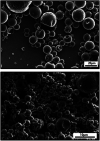Engineering encapsulated ionic liquids for next-generation applications
- PMID: 35492767
- PMCID: PMC9043619
- DOI: 10.1039/d1ra05034f
Engineering encapsulated ionic liquids for next-generation applications
Abstract
Ionic liquids (ILs) have attracted considerable attention in several sectors (from energy storage to catalysis, from drug delivery to separation media) owing to their attractive properties, such as high thermal stability, wide electrochemical window, and high ionic conductivity. However, their high viscosity and surface tension compared to conventional organic solvents can lead to unfavorable transport properties. To circumvent undesired kinetics effects limiting mass transfer, the discretization of ILs into small droplets has been proposed as a method to increase the effective surface area and the rates of mass transfer. In the present review paper, we summarize the different methods developed so far for encapsulating ILs in organic or inorganic shells and highlight characteristic features of each approach, while outlining potential applications. The remarkable tunability of ILs, which derives from the high number of anions and cations currently available as well as their permutations, combines with the possibility of tailoring the composition, size, dispersity, and properties (e.g., mechanical, transport) of the shell to provide a toolbox for rationally designing encapsulated ILs for next-generation applications, including carbon capture, energy storage devices, waste handling, and microreactors. We conclude this review with an outlook on potential applications that could benefit from the possibility of encapsulating ILs in organic and inorganic shells.
This journal is © The Royal Society of Chemistry.
Conflict of interest statement
The authors declare no competing financial interests.
Figures









Similar articles
-
Encapsulation of Ionic Liquids for Tailored Applications.ACS Appl Mater Interfaces. 2020 Feb 5;12(5):5169-5176. doi: 10.1021/acsami.9b16546. Epub 2019 Nov 26. ACS Appl Mater Interfaces. 2020. PMID: 31721558
-
Ionogels, ionic liquid based hybrid materials.Chem Soc Rev. 2011 Feb;40(2):907-25. doi: 10.1039/c0cs00059k. Epub 2010 Dec 22. Chem Soc Rev. 2011. PMID: 21180731
-
Long-Chain Ionic Liquids Based on Monoquaternary DABCO Cations and TFSI Anions: Towards Stable Electrolytes for Electrochemical Capacitors.Chempluschem. 2020 Dec;85(12):2679-2688. doi: 10.1002/cplu.202000680. Chempluschem. 2020. PMID: 33326698
-
Ionic liquids in surface electrochemistry.Phys Chem Chem Phys. 2010 Feb 28;12(8):1685-97. doi: 10.1039/b921469k. Epub 2010 Jan 26. Phys Chem Chem Phys. 2010. PMID: 20145833 Review.
-
Ionic liquids as active pharmaceutical ingredients.ChemMedChem. 2011 Jun 6;6(6):975-85. doi: 10.1002/cmdc.201100082. Epub 2011 May 9. ChemMedChem. 2011. PMID: 21557480 Review.
Cited by
-
Ionic Liquid-Functionalized Periodic Mesoporous Organosilica: A Robust Support for Palladium Nanoparticles in Carbonylative Suzuki Coupling Reactions.Chem Asian J. 2025 May 15;20(10):e202401802. doi: 10.1002/asia.202401802. Epub 2025 Mar 19. Chem Asian J. 2025. PMID: 39989383 Free PMC article.
-
Novel Oxygen- and Curcumin-Laden Ionic Liquid@Silica Nanocapsules for Enhanced Antimicrobial Photodynamic Therapy.Pharmaceutics. 2023 Mar 28;15(4):1080. doi: 10.3390/pharmaceutics15041080. Pharmaceutics. 2023. PMID: 37111567 Free PMC article.
-
Transparent Gelation of Ionic Liquids Trapped in Silicone Microcup Structures under Scanning Electron Microscopy.Gels. 2023 Feb 24;9(3):179. doi: 10.3390/gels9030179. Gels. 2023. PMID: 36975628 Free PMC article.
-
Deep learning models to predict CO2 solubility in imidazolium-based ionic liquids.Sci Rep. 2025 Jul 21;15(1):26445. doi: 10.1038/s41598-025-12004-8. Sci Rep. 2025. PMID: 40691294 Free PMC article.
References
-
- MacFarlane D. R., Kar M. and Pringle J. M., An Introduction to Ionic Liquids, in Fundamentals of Ionic Liquids, Wiley-VCH Verlag GmbH & Co. KGaA, 2017, pp. 1–25, 10.1002/9783527340033.ch1 - DOI
-
- Earle M. J. Seddon K. R. Ionic Liquids. Green Solvents for the Future. Pure Appl. Chem. 2000;72(7):1391–1398. doi: 10.1351/pac200072071391. - DOI
Publication types
LinkOut - more resources
Full Text Sources

